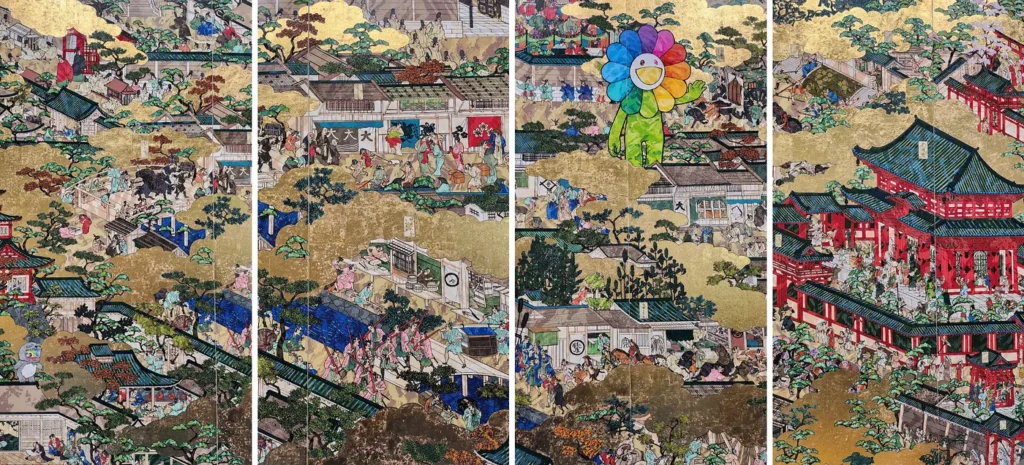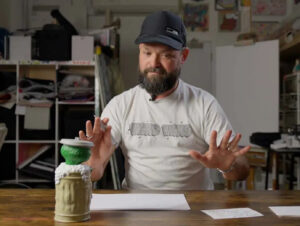Catching Murakami’s First Large-Scale Solo Show Outside of Tokyo
Takashi Murakami, one of the most influential contemporary artists of our time, is celebrated for his signature Superflat aesthetic, which blends traditional Japanese art with pop culture, manga, and consumerism. His latest exhibition, Kyoto Mononoke, held at the Kyocera Museum of Art, marks his first large-scale solo show outside of Tokyo, making it a significant milestone in his illustrious career.
With Kyoto’s rich artistic and cultural history as a backdrop, Kyoto Mononoke explores themes of folklore, spirits (mononoke), and Murakami’s own interpretation of Japan’s past and present. This exhibition is more than just a showcase of his famous colorful flowers, smiling characters, and anime-inspired figures—it is a deeper dive into his artistic evolution, philosophical inquiries, and the eerie yet beautiful world of supernatural beings that have long fascinated Japanese culture.
Takashi Murakami: The Visionary Behind Superflat
Before delving into Kyoto Mononoke, it is essential to understand Takashi Murakami’s impact on contemporary art. Born in 1962, Murakami studied traditional nihonga (Japanese painting) at the Tokyo University of the Arts but soon became captivated by the intersection of fine art and mass-produced commercial imagery. This led him to develop Superflat, a postmodern art movement that critiques the shallow, consumer-driven culture of post-war Japan while celebrating the flat aesthetics of anime and manga.
Murakami’s blend of traditional and contemporary elements, his playful yet subversive characters, and his use of commercial production techniques have made him a global sensation. From his collaborations with brands like Louis Vuitton, Supreme, and Virgil Abloh to his work with musicians like Kanye West, his art transcends boundaries between high and low culture.
However, despite his international success, Murakami has long maintained a deep connection with Japanese history, folklore, and spirituality, all of which play a crucial role in Kyoto Mononoke.
The Significance of Kyoto Mononoke
Murakami’s decision to stage his first major solo exhibition outside of Tokyo in Kyoto is significant. Kyoto, the ancient capital of Japan, is steeped in history, art, and spirituality. It is home to traditional temples, Zen gardens, and centuries-old artistic traditions, making it an ideal setting for an exhibition that explores the past’s lingering spirits (mononoke).
The exhibition title, Kyoto Mononoke, references supernatural beings from Japanese folklore—spirits that exist between worlds, often depicted as ghosts, yokai (monsters), or shapeshifters. These spirits have long been a subject of fascination in Japanese art and literature, from Heian-period tales like “The Tale of Genji” to contemporary horror films like “Ringu” (The Ring).
Murakami’s exploration of mononoke is not just an artistic theme but also a metaphor for Japan’s lingering ghosts—its history, trauma, and cultural transformation in the face of modernity. In Kyoto Mononoke, he merges his contemporary, brightly colored pop aesthetic with eerie, otherworldly imagery, creating a haunting yet beautiful visual experience.
The Spiritual and the Supernatural
The mononoke of Japanese folklore are neither entirely good nor entirely evil—they exist in liminal spaces, embodying unresolved emotions, unfinished business, or the blurred boundaries between life and death. Murakami brings this concept to life with his unique style, infusing his characters with an uncanny, ghostly presence that makes them both charming and unsettling.
One of the most striking aspects of Kyoto Mononoke is how Murakami uses traditional Japanese art motifs, such as ukiyo-e and Buddhist iconography, but reimagines them with modern materials and colors. His ghostly figures, surreal landscapes, and hybrid creatures reflect an ongoing dialogue between past and present, ancient beliefs and contemporary anxieties.
The Influence of Nihonga and Buddhist Art
Despite being best known for his cartoonish, vibrant works, Murakami’s roots in nihonga painting and Buddhist art are evident throughout Kyoto Mononoke. He often references Buddhist deities, demons, and mandalas, but with his own spin—sometimes incorporating manga-style eyes, neon colors, or metallic finishes.
This fusion highlights how spirituality and artistic expression have always been intertwined in Japanese culture. By bringing Buddhist-inspired imagery into a contemporary art space, Murakami challenges viewers to reconsider the relevance of spiritual art in modern times.
The Intersection of Pop Culture and History
Murakami is a master of blending pop culture with historical themes, and Kyoto Mononoke continues this tradition. While the exhibition is deeply rooted in folklore, he also incorporates anime, video game aesthetics, and modern-day commercial imagery.
For instance, his famous flower motifs—which are often perceived as symbols of happiness—take on a slightly eerie quality when placed alongside ghostly figures. Similarly, his iconic Mr. DOB character, often seen as a critique of consumer culture, is reinterpreted in new ways that align with the supernatural themes of the exhibition.
By merging past and present, Murakami suggests that mononoke are not just relics of the past but also representations of contemporary fears—technological anxieties, environmental concerns, and the ghosts of history that continue to shape Japan today.
Murakami’s Large-Scale Installations: A Visual Spectacle
A key highlight of Kyoto Mononoke is its monumental scale. Murakami is known for creating massive paintings and sculptures that overwhelm the viewer, and this exhibition is no exception.
Some of the standout pieces include:
•A large-scale mural featuring traditional Japanese ghosts and demons intertwined with Murakami’s signature characters.
•A towering sculpture of a modern-day yokai, blending robotic and organic elements.
•Intricately detailed paintings that combine Buddhist iconography with anime-style visuals.
These grand installations create a fully immersive experience, drawing viewers into Murakami’s supernatural universe.
Why Kyoto Mononoke is a Must-See Exhibition
Murakami’s Kyoto Mononoke is not just an exhibition—it is a statement about history, spirituality, and the evolving nature of Japanese identity. Here’s why it is a must-see event:
A Unique Fusion of Tradition and Modernity
The exhibition showcases how ancient beliefs and contemporary aesthetics can coexist, offering a fresh perspective on Japanese folklore.
Murakami’s Artistic Evolution
While Murakami is best known for his pop art, Kyoto Mononoke reveals his depth, complexity, and ability to tackle profound themes beyond his usual commercial collaborations.
A Rare Opportunity to See His Work in Kyoto
This is Murakami’s first major solo exhibition outside of Tokyo, making it a rare chance to experience his large-scale works in a city that has historically been the heart of Japan’s art and culture.
Immersive and Visually Stunning
The scale, detail, and sheer creativity of Kyoto Mononoke make it a once-in-a-lifetime visual experience that is as thought-provoking as it is aesthetically breathtaking.
Impression
Takashi Murakami’s Kyoto Mononoke at the Kyocera Museum of Art is a groundbreaking exhibition that redefines contemporary Japanese art. By blending ancient folklore, Buddhist iconography, pop culture, and modern anxieties, Murakami creates a surreal, immersive experience that lingers in the mind long after viewing.
This exhibition is not just about ghosts—it is about the spirits of history, memory, and cultural evolution. Whether you are a long-time fan of Murakami or a newcomer to his work, Kyoto Mononoke offers a rich, multidimensional experience that makes it one of the most compelling art events of the year.
For those who appreciate art, history, and the supernatural, this is an exhibition not to be missed.
No comments yet.









